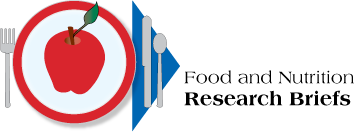This page has been archived and is being provided for reference purposes only. The page is no longer being updated, and therefore, links on the page may be invalid.
| January 2016 |
Connecting Overeating, Emotions and Cognitive Control in Young ChildrenAgricultural Research Service (ARS) researchers have found the first relationship between cognitive control and emotional eating behavior in preschool children. They found cognitive control—which includes abilities to make decisions, plan, manage time, and maintain emotional and self-control—is significantly associated with the relationship between overeating and emotions. Researchers examined the balance between emotional state, snacking, and cognitive control in children ages 3 to 6 at a preschool on the University of California, Davis campus. They used computerized and hands-on tasks, parent questionnaires, and standardized teacher reports to measure cognitive control and assign a cognitive control score. Results, which were published in Appetite, indicate that young children with lower cognitive control skills may be more likely to overeat when experiencing heightened emotions, while children with higher cognitive control skills are less likely to overeat. For details, contact: Kevin Laugero, (530) 752-4173, Obesity and Metabolism Research Unit, Western Human Nutrition Research Center, Davis, California. |
|
|
|
Low Vitamin D Linked to Osteoarthritis in the KneeA study supported in part by the Agricultural Research Service (ARS) suggests that without adequate vitamin D in the diet, people may be at increased risk of developing osteoarthritis in their knees. Osteoarthritis occurs when the natural cushioning between joints in the body wears away, allowing bones to rub together. Researchers focused on 418 volunteers for whom blood serum concentrations of vitamin D and radiographs to assess knee osteoarthritis progression were available. The volunteers were followed for 4 years and monitored for knee osteoarthritis progression and vitamin D levels in their blood. Compared to volunteers with healthy levels, participants with low vitamin D levels had more than double the risk of their knee osteoarthritis worsening during the study. Scientists concluded that increased, adequate dietary intake may be beneficial for those with knee osteoarthritis. For details, contact: Sarah Booth, Associate Director, (617) 556-3231, USDA Jean Mayer Human Nutrition Research Center on Aging, Boston, Massachusetts. |
E. coli Gets a Boost from Lettuce DiseaseEscherichia coli O157:H7, a bacterium that causes foodborne illness in humans, is more likely to contaminate lettuce when downy mildew is already present. Downy mildew, a lettuce disease caused by the fungus-like water mold Bremia lactucae, is one of the biggest problems lettuce growers must deal with. The question is why so many E. coli O157:H7 outbreaks can be traced back to lettuce fields when E. coli O157:H7 sources are as diverse as undercooked beef, sprouts, raw dairy, shelled walnuts, fruits and vegetables. ARS researchers found that under warm temperatures and on wet leaves, E. coli O157:H7 multiplied 1,000-fold more in downy mildew lesions than on healthy lettuce leaf tissue. Even on dry lettuce leaves, where most bacteria struggle to survive, E. coli O157:H7 persisted in greater numbers when downy mildew disease was present. E. coli O157:H7 did not grow as well in downy mildew lesions on the downy mildew resistant lettuce line RH08 as the bacteria did on Triple Threat, a commercial variety highly susceptible to downy mildew. For details, contact: Maria Brandl, (510) 559-5885, Produce Safety and Microbiology Research Unit, Western Regional Research Center, Albany, California. |
|
|
|
A Wash that Reduces Health Risks in Fresh ProduceAn Agricultural Research Service (ARS) scientist in Pennsylvania has developed a sanitizing wash that could reduce the number of foodborne illnesses caused each year by E. coli,Salmonella, and Listeria from fresh-cut produce. The solution works better than water, chlorinated water, or hydrogen peroxide at ridding surface bacteria from produce. It rids cantaloupes, honeydew melons, and other produce of bacteria that can migrate on to cut pieces. U.S. Centers for Disease Control and Prevention data show that each year about 1 in 6 Americans (or 48 million people) get sick, 128,000 are hospitalized, and 3,000 die of foodborne diseases. The wash, which is called "Lovit," could be formulated into a spray and used by food processors, supermarkets, restaurants, and anyone concerned about food safety. A patent application has been filed, and a commercial partner has expressed interested in marketing the wash. For details, contact: Dike Ukuku, (215) 233-6427, Food Safety and Intervention Technologies Research Unit, Wyndmoor, Pennsylvania. |
Wine Grape Flour Reduces Cholesterol in Lab Animal StudyThe potential health benefits of specialty flours—particularly those made from wine grape seeds—are being investigated. Working with WholeVine Products, a Sonoma, California, company that makes wine grape flours, Agricultural Research Service (ARS) chemist Wallace Yokoyama found that hamsters fed diets similar in caloric content to the American diet mixed with Chardonnay white wine grape seeds had reduced blood cholesterol, hepatic steatosis—also known as "fatty liver"—and weight gain compared to hamsters fed diets without grape seeds or Cabernet Sauvignon or Syrah red grape seed flour. Hamsters were used in these preliminary laboratory experiments because they absorb cholesterol from food and synthesize it in the liver, in a similar manner to humans. Yokoyama and his team also examined changes in the activity of some of the genes associated with obesity. They found that leptin, which is usually high in people who are obese, decreased. Adiponectin, which is believed to help prevent diabetes and atherosclerosis, increased. For details, contact: Wallace Yokoyama, (510) 559-5695, Healthy Processed Foods Research Unit, Western Regional Research Center, Albany, California. |
|
|
|
Food Toxin Detector Incorporates CameraA new system that incorporates a digital camera to detect pathogens that cause foodborne illness has been developed by Agricultural Research Service (ARS) scientists. The high cost of equipment used to identify pathogens restricts widespread testing of foods for toxins that cause food poisoning, which sickens millions of Americans each year. The new system measures Shiga toxin activity as effectively as equipment that costs 100 times more. The new inexpensive system, which can distinguish between active and inactive toxins, uses a $300 camera and a light-emitting source to biologically identify active toxins. A fluorometer, which is generally used to detect toxins, costs about $35,000. The system is easy to adapt and also can be used to detect other foodborne toxins. For details, contact: Reuven Rasooly, (510) 559-6478, Foodborne Toxin Detection and Prevention Unit, Western Regional Research Center Albany, California. |
Confirming Nutrient Content of SupplementsThe Dietary Supplement Ingredient Database Version 3.0 (DSID-3), a database that validates the contents of dietary supplements, has been updated to help researchers more accurately determine relationships between dietary supplement use and public health. This is the third edition of the data resource released by scientists from the Agricultural Research Service (ARS) and the National Institutes of Health (NIH). DSID-3 is designed to help researchers estimate nutrient intakes from dietary supplements. For example, most multivitamin and mineral supplements (MVMs) contain iodine, but the DSID-3 shows that labels for adult, child, and non-prescription prenatal MVMs consistently underreport iodine levels by about 25 percent, based on chemical analyses. The DSID-3 is available at https://dietarysupplementdatabase.usda.nih.gov/releases_3.php For details, contact: Karen Andrews, (301) 504-0710, Nutrient Data Laboratory, Beltsville Human Nutrition Research Center, Beltsville, Maryland. |
|
|
|
Quick-Serve Foods Slow To ChangeAgricultural Research Service (ARS)-funded scientists investigated trends in portion sizes and the calorie, sodium, saturated fat and trans fat content of popular meal combos at U.S. quick-serve chain restaurants. They found little change in portion sizes during an 18-year period. On a positive note, the study recorded a decline in trans fat content of French fries during the study period. The team gathered data on 27 common food items served from three quick-serve chains, commonly called "fast food" restaurants, between 1996 and 2013. They also examined the classic bundled meal of fries, cola and a burger. The team found that based on data from 2013 alone, a large-sized combo meal (large cheeseburger, large fries and a large sweetened cola) at the three chains contained between 65 percent and 80 percent of the estimated daily calorie needs of an individual adult. For details, contact: Alice H. Lichtenstein, (617) 556-3127, Cardiovascular Nutrition Laboratory, USDA Jean Mayer Human Nutrition Research Center on Aging, Boston, Massachusetts. |
Consumers Missing Out on Health Benefits of Seafood ConsumptionStudies by Agricultural Research Service (ARS) scientists show that while most U.S. consumers eat some seafood, the amounts are inadequate to meet federal dietary guidelines. Both fish and shellfish, referred to as "seafood," are nutrient-rich protein foods, and consumption has been associated with reduced heart disease risk. The 2010 Dietary Guidelines for Americans, in effect at the time of the study, recommended eating two servings of seafood (about 8 ounces) weekly to get at least 1,750 milligrams of two omega-3s known as EPA (eicosapentaenoic acid) and DHA (docosahexaenoic acid) weekly. The data were collected during the national survey known as "What We Eat in America/NHANES." Overall, about 80 to 90 percent of U.S. consumers did not meet their seafood recommendations. Additionally, a review of published studies that explored fish consumption’s link to heart health pointed to consistent evidence supporting a reduced risk of heart disease due particularly to eating oily fish. For details, contact: Lisa A. Jahns, (701) 795-8331, Grand Forks Human Nutrition Research Center, Grand Forks, North Dakota. |
|
|
|
A New Blueberry for Home GrowersThe Agricultural Research Service (ARS) was recently awarded a patent for Nocturne, a new blueberry cultivar. It is a vigorous, winter-hardy, black-fruited blueberry, especially notable for being slow to break dormancy in spring, making it unlike any other rabbiteye blueberry hybrids currently available. This variety is intended to be a specialty market plant for home, landscape, and ornamental use, which incorporates germplasm from three different blueberry species, including one with extreme cold-hardiness. DetailsFor details, contact: Mark Ehlenfeldt, (609) 726-1590 ex. 4421, Genetic Improvement of Fruits and Vegetables, Chatsworth, New Jersey. |











